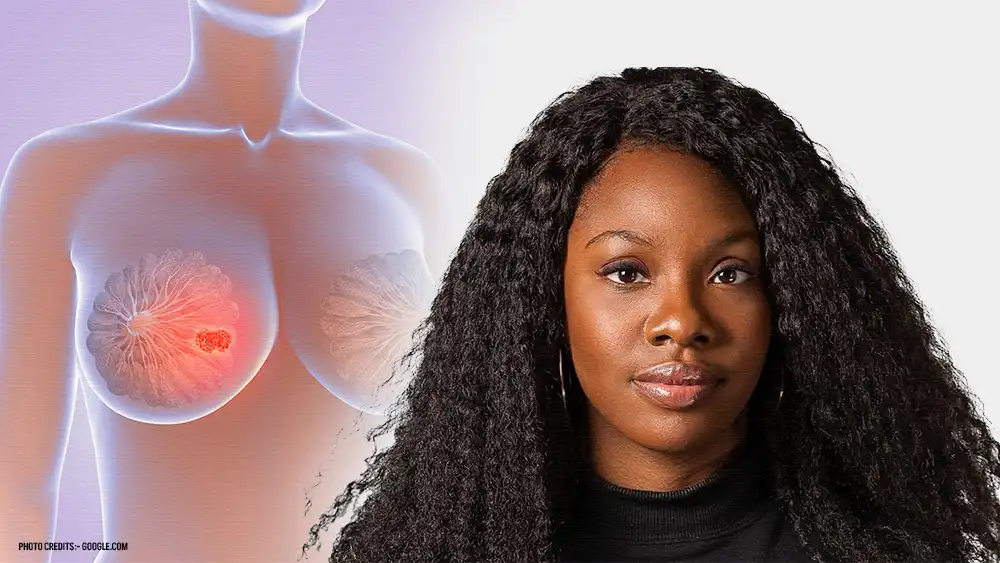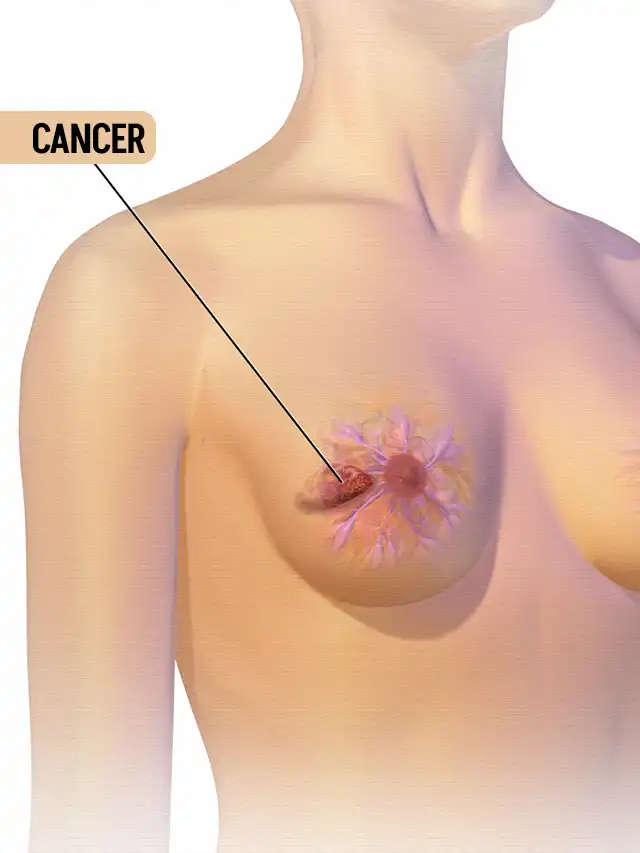
HEALTH BLOG
Breast Cancer- Prevention, Types and Treatment
-
 Rahul Priydarss
Rahul Priydarss - April 7, 2024
Discover comprehensive insights into breast cancer, including its definition, types, risk factors, diagnosis, treatment options, prevention strategies, and advancements in research. Learn about the importance of understanding breast cancer, early detection methods, and support resources available. Empower yourself with knowledge to navigate the complexities of breast cancer effectively.
What is Breast Cancer:
Breast cancer is a type of cancer that forms in the cells of the breast tissue. It occurs when abnormal cells grow uncontrollably, forming a tumor in the breast. These cancerous cells can invade surrounding tissues and potentially spread to other parts of the body, a process known as metastasis.
Breast cancer is a prevalent and concerning health issue that affects millions of individuals worldwide. It is characterized by the abnormal growth of cells in the breast tissue, often forming a lump or mass. This type of cancer can affect both men and women, although it is far more common in women.
The importance of understanding breast cancer cannot be overstated. It is the most commonly diagnosed cancer among women globally, with significant implications for health and well-being. Early detection and treatment are crucial in improving outcomes and reducing mortality rates associated with this disease.

Table of Contents
Understanding Breast Cancer:
Breast cancer is a type of malignancy that originates in the breast tissue. It occurs when abnormal cells in the breast grow out of control, forming a tumor. These tumors can either be benign (non-cancerous) or malignant (cancerous). Malignant tumors have the potential to invade nearby tissues and spread to other parts of the body, a process known as metastasis.
Types of Brest Cancer:
There are several types of breast cancer, each classified based on where in the breast they originate and their specific characteristics. The most common types include. There are several types of breast cancer, each classified based on where in the breast they originate and their characteristics.
Ductal Carcinoma In Situ (DCIS): DCIS is a non-invasive type of breast cancer that begins in the milk ducts of the breast. It has not spread into surrounding breast tissue.
Invasive Ductal Carcinoma (IDC): IDC is the most common type of breast cancer, accounting for about 80% of cases. It starts in the breast’s milk ducts and can spread to surrounding tissue if not treated.
Lobular Carcinoma In Situ (LCIS): LCIS is a non-invasive type of breast cancer that begins in the lobules of the breast, where milk is produced.
Invasive Lobular Carcinoma (ILC): ILC begins in the breast’s lobules and can spread to nearby tissue and other body parts.
Risk Factors of Brest Cancer:
The exact causes of breast cancer are not fully understood, but several risk factors have been identified.
Gender: Breast cancer is much more common in women than in men. Although men can develop breast cancer, it is rare.
Age: The risk of developing breast cancer increases with age. Most cases are diagnosed in women over the age of 50.
Family History: Having a close relative, such as a mother, sister, or daughter, who has had breast cancer increases the risk of developing the disease.
Genetic Mutations: Inherited mutations in certain genes, such as BRCA1 and BRCA2, can increase the risk of breast cancer.
Hormonal Factors: Hormonal factors, such as early menstruation, late menopause, and hormone replacement therapy, can affect the risk of breast cancer.
Lifestyle Factors: Factors such as obesity, lack of physical activity, alcohol consumption, and smoking may increase the risk of developing breast cancer.
Exposure to Radiation: Previous radiation therapy to the chest for another cancer or medical condition can increase the risk of breast cancer.
Signs and Symptoms of Breast Cancer:
Breast cancer can present with various signs and symptoms, and it’s essential to be aware of them for early detection and prompt medical attention. Here are some common signs and symptoms of breast cancer.
Lump or Mass: The most common sign of breast cancer is the presence of a lump or mass in the breast tissue. This lump may feel hard, irregular shape, and different from surrounding breast tissue.
Changes in Breast Size or Shape: Breast cancer may cause changes in the size or shape of the breast. One breast may become larger or lower than the other, or there may be visible distortion or asymmetry.
Nipple Changes: Changes in the appearance or texture of the nipples can be a sign of breast cancer. This may include nipple inversion (turning inward), nipple discharge (other than breast milk), or changes in nipple color or texture.
Skin Changes: Breast cancer can cause changes in the skin of the breast or nipple area. These changes may include redness, dimpling, puckering, or thickening of the skin, resembling the texture of an orange peel.
Breast Pain or Sensitivity: While breast pain is not usually a common symptom of breast cancer, some individuals may experience persistent breast pain or tenderness that does not resolve with time or changes in menstrual cycles.
Swelling or Lymph Node Enlargement: In some cases, breast cancer may cause swelling or enlargement of lymph nodes in the underarm area (axilla) or around the collarbone. These swollen lymph nodes may feel tender or firm to the touch.
Changes in Breast Texture: Breast cancer may cause changes in the texture of the breast tissue, such as thickening or prominence of veins on the breast surface.
Diagnosis of Breast Cancer:
The diagnosis of breast cancer typically involves a combination of screening tests, imaging studies, and tissue analysis. Early detection is crucial for improving treatment outcomes and increasing the chances of successful recovery. Here is an overview of the diagnostic process for breast cancer.
Clinical Breast Examination (CBE): A clinical breast examination is performed by a healthcare provider to assess the breasts for any abnormalities, such as lumps, changes in size or shape, or skin dimpling.
Mammography: Mammography is the most common screening tool for detecting breast cancer. It involves taking X-ray images of the breast tissue to identify any suspicious areas, such as masses or calcifications.
Breast Ultrasound: In some cases, a breast ultrasound may be performed to further evaluate abnormalities detected on a mammogram or to assess breast lumps that can be felt but are not visible on mammography.
Breast Magnetic Resonance Imaging (MRI): Breast MRI may be recommended in certain situations, such as for women at high risk of breast cancer or to evaluate the extent of the disease in newly diagnosed cases.
Biopsy: If suspicious findings are detected on imaging studies or clinical examination, a biopsy is typically performed to obtain a tissue sample for analysis. There are different types of breast biopsies, including:
- Fine Needle Aspiration (FNA): A thin needle is used to withdraw cells or fluid from a breast lump for analysis.
- Core Needle Biopsy: A larger needle is used to remove a small core of tissue from the suspicious area for examination.
- Surgical Biopsy: In some cases, a surgical biopsy may be necessary to remove a larger sample of tissue for analysis. This may involve an incisional biopsy, where only a portion of the suspicious area is removed, or an excisional biopsy, where the entire lump or abnormal area is removed.
Pathology Analysis: The tissue samples obtained from the biopsy are sent to a pathology laboratory, where they are examined under a microscope by a pathologist. The pathologist evaluates the cells for signs of cancer, such as abnormal cell growth and changes in cell structure.
Breast Cancer Staging: Once a diagnosis of breast cancer is confirmed, further tests may be performed to determine the stage of the disease. This may include imaging studies, such as CT scans, PET scans, or bone scans, to assess the extent of cancer spread to other parts of the body.
Genetic Testing: In some cases, genetic testing may be recommended to identify inherited mutations, such as BRCA1 and BRCA2, which increase the risk of breast cancer.

Treatment Options for Breast Cancer:
The treatment of breast cancer depends on several factors, including the type and stage of the cancer, as well as the patient’s overall health and preferences. Treatment typically involves a combination of therapies aimed at removing or destroying cancer cells, preventing recurrence, and preserving overall well-being. Here are the primary treatment options for breast cancer.
Surgery:
- Lumpectomy (Breast-Conserving Surgery): This surgical procedure involves removing the tumor and a surrounding margin of healthy breast tissue while preserving the rest of the breast. It is typically performed for early-stage breast cancer.
- Mastectomy: Mastectomy involves surgical removal of the entire breast. There are different types of mastectomy, including total mastectomy (removal of the entire breast tissue), modified radical mastectomy (removal of the entire breast tissue along with the underlying muscle), and skin-sparing mastectomy (preserving the breast skin for breast reconstruction).
- Sentinel Lymph Node Biopsy: During surgery, the surgeon may also perform a sentinel lymph node biopsy to determine if cancer has spread to nearby lymph nodes. This helps guide further treatment decisions.
Radiation Therapy: Radiation therapy uses high-energy beams to destroy cancer cells. It is often recommended after surgery to reduce the risk of cancer recurrence. Radiation may also be used to shrink tumors before surgery (neoadjuvant radiation) or to alleviate symptoms in advanced cases.
Chemotherapy: Chemotherapy involves the use of powerful medications to kill cancer cells or stop their growth. It may be administered before surgery (neoadjuvant chemotherapy) to shrink tumors, after surgery (adjuvant chemotherapy) to destroy any remaining cancer cells, or as the primary treatment for advanced or metastatic breast cancer.
Hormone Therapy: Hormone therapy is used to treat hormone receptor-positive breast cancers, which account for the majority of breast cancer cases. It works by blocking the effects of estrogen or progesterone, hormones that can promote the growth of certain types of breast cancer cells. Hormone therapy may involve medications such as tamoxifen, aromatase inhibitors, or ovarian suppression therapy.
Targeted Therapy: Targeted therapy drugs specifically target cancer cells by interfering with specific molecules involved in cancer growth and progression. Examples of targeted therapy drugs used in breast cancer treatment include trastuzumab (Herceptin) for HER2-positive breast cancer and pertuzumab (Perjeta) in combination with trastuzumab.
Immunotherapy: Immunotherapy harnesses the body’s immune system to recognize and destroy cancer cells. While not yet a standard treatment for all breast cancers, immunotherapy may be used in certain cases, particularly for triple-negative breast cancer or HER2-positive breast cancer that has not responded to other treatments.
Breast Reconstruction: Following mastectomy, women may choose to undergo breast reconstruction surgery to restore the shape and appearance of the breast. Reconstruction can be performed using implants or tissue from other parts of the body (autologous reconstruction).
Prevention of Breast Cancer:
While it’s not always possible to prevent breast cancer entirely, certain lifestyle choices and preventive measures can help reduce the risk of developing the disease. Here are some strategies for breast cancer prevention.
Maintain a Healthy Weight: Being overweight or obese increases the risk of breast cancer, especially after menopause. Aim to maintain a healthy weight through a balanced diet and regular physical activity.
Stay Physically Active: Engage in regular physical activity, such as brisk walking, jogging, cycling, or swimming, for at least 150 minutes per week. Exercise helps reduce breast cancer risk by regulating hormone levels and boosting the immune system.
Limit Alcohol Consumption: Limit alcohol intake to no more than one drink per day for women. Excessive alcohol consumption is associated with an increased risk of breast cancer.
Quit Smoking: Smoking is linked to a higher risk of breast cancer, particularly in premenopausal women. If you smoke, seek support to quit smoking and avoid exposure to secondhand smoke.
Eat a Healthy Diet: Choose a diet rich in fruits, vegetables, whole grains, lean proteins, and healthy fats. Limit intake of processed and red meats, sugary foods, and high-fat dairy products. A healthy diet helps maintain overall health and reduces the risk of obesity and related conditions.
Breastfeed, if Possible: Women who breastfeed their babies may have a reduced risk of developing breast cancer. Breastfeeding can help lower estrogen levels in the body and may have long-term protective effects.
Limit Hormone Therapy: Use hormone replacement therapy (HRT) for menopausal symptoms only when necessary and for the shortest duration possible. Long-term use of combined estrogen and progesterone therapy may increase the risk of breast cancer.
Be Proactive with Screening: Follow recommended screening guidelines for breast cancer, including regular mammograms and clinical breast exams. Early detection through screening can lead to earlier diagnosis and better treatment outcomes.
Know Your Family History: Be aware of your family history of breast cancer and other cancers. If you have a family history of breast cancer or inherited genetic mutations (such as BRCA1 or BRCA2), discuss screening and risk-reduction options with your healthcare provider.
Limit Exposure to Environmental Carcinogens: Minimize exposure to environmental toxins and carcinogens, such as radiation, chemicals, and pollutants, whenever possible. Follow safety precautions in the workplace and at home to reduce exposure to potentially harmful substances.
Use Good Quality Bra: Wearing a good quality bra is often recommended as part of breast cancer prevention and support. While there’s no direct link between wearing bras and developing breast cancer, a properly fitted bra provides adequate support, reducing strain on breast tissue.
Advancements in Research for Brest Cancer:
Over the past few decades, significant progress has been made in understanding the biology of breast cancer and developing new treatment approaches. Ongoing research efforts continue to drive innovations aimed at improving outcomes for patients with breast cancer. Here are some of the recent advancements in breast cancer research.
Precision Medicine: Precision medicine, also known as personalized medicine, involves tailoring treatment strategies to the unique characteristics of each individual’s cancer. Advances in genomic testing and molecular profiling have enabled oncologists to identify specific genetic mutations and molecular markers associated with breast cancer. This information helps guide treatment decisions and select targeted therapies that are most likely to be effective for each patient.
Immunotherapy: Immunotherapy has emerged as a promising treatment approach for certain types of breast cancer. Immunotherapy drugs, such as checkpoint inhibitors, work by stimulating the body’s immune system to recognize and attack cancer cells. Clinical trials are underway to evaluate the efficacy of immunotherapy in breast cancer, particularly in triple-negative breast cancer and HER2-positive breast cancer.
Targeted Therapies: Targeted therapies aim to disrupt specific molecular pathways involved in cancer growth and progression. Drugs targeting HER2, such as trastuzumab (Herceptin) and pertuzumab (Perjeta), have revolutionized the treatment of HER2-positive breast cancer, improving survival outcomes for patients. New targeted therapies are being developed to target other molecular pathways implicated in breast cancer, offering additional treatment options for patients with advanced or treatment-resistant diseases.
Liquid Biopsies: Liquid biopsies, also known as circulating tumor DNA (ctDNA) tests, involve analyzing blood samples to detect genetic mutations and other molecular changes associated with cancer. Liquid biopsies offer a non-invasive method for monitoring disease progression, assessing treatment response, and detecting the emergence of treatment-resistant mutations in real time. This technology holds promise for personalized treatment planning and early intervention in breast cancer patients.
Minimally Invasive Surgery: Advances in surgical techniques and technology have led to the development of minimally invasive approaches for breast cancer surgery. Techniques such as laparoscopic and robotic-assisted surgery offer smaller incisions, reduced postoperative pain, shorter recovery times, and improved cosmetic outcomes compared to traditional open surgery. Minimally invasive surgery may be suitable for selected patients with early-stage breast cancer or as part of breast-conserving therapy.
Liquid Biopsies: Liquid biopsies, also known as circulating tumor DNA (ctDNA) tests, involve analyzing blood samples to detect genetic mutations and other molecular changes associated with cancer. Liquid biopsies offer a non-invasive method for monitoring disease progression, assessing treatment response, and detecting the emergence of treatment-resistant mutations in real time. This technology holds promise for personalized treatment planning and early intervention in breast cancer patients.
Artificial Intelligence (AI) and Machine Learning: AI and machine learning algorithms are being increasingly utilized in breast cancer research and clinical practice. These technologies can analyze vast amounts of medical data, including imaging studies, pathology reports, and genomic profiles, to identify patterns, predict treatment outcomes, and optimize treatment strategies. AI-driven tools hold the potential to enhance diagnostic accuracy, personalize treatment regimens, and improve patient outcomes in breast cancer care.
Preventive Strategies: Research efforts are also focused on developing preventive strategies to reduce the risk of breast cancer and prevent disease recurrence. This includes investigating the role of lifestyle interventions, chemoprevention agents, and prophylactic surgeries in high-risk individuals. Identifying effective preventive measures is crucial for reducing the overall burden of breast cancer and improving long-term population health.
More precise treatment:
- Genetic testing helps identify women at higher risk and personalize treatment plans (https://www.cancer.org/research/acs-research-highlights/breast-cancer-research-highlights.html)
- Liquid biopsies are minimally invasive tests that analyze circulating tumor DNA (ctDNA) in the bloodstream to monitor cancer and treatment response.
- AI-powered imaging is being developed to improve mammogram accuracy and reduce false positives.
Breast Cancer Awareness Campaigns:
Breast Cancer Awareness Month in 2023 ran throughout October with a focus on education, early detection, and community support. Here are some key details about the campaign.
Theme: “Keeping Her in the Picture” aimed to raise awareness about the importance of breast health for women in everyone’s lives.
Slogan: “Pink Together, Stronger Forever” emphasized the power of unity and collective action in the fight against breast cancer.
Activities: Many organizations held events, walks, and fundraisers throughout October. Some examples include.
- Free or low-cost mammogram screenings
- Educational workshops on breast self-examination and risk factors
- Support groups for breast cancer patients and survivors
- Landmark buildings lighting up pink in support of the cause
National Breast Cancer Awareness Month: Awareness Days Events Calendar: https://www.awarenessdays.com/awareness-days-calendar/breast-cancer-awareness-month-2023
FAQs about Brest Cancer:
A1: Several factors contribute to the development of breast cancer, including age, family history, genetic mutations (e.g., BRCA1 and BRCA2), hormonal factors, lifestyle choices (e.g., diet, alcohol consumption), and environmental exposures.
A2: While breast cancer is more commonly diagnosed in women, men can also develop the disease, albeit at a much lower frequency. Both men and women need to be aware of the signs and symptoms of breast cancer and seek medical attention if any abnormalities are noticed.
A3: Treatment for breast cancer varies depending on the stage of the disease, its characteristics, and individual patient factors. Common treatment modalities include surgery (lumpectomy or mastectomy), chemotherapy, radiation therapy, hormone therapy, and targeted therapy.
A4: Supporting a loved one with breast cancer involves offering emotional support, assisting with practical tasks, accompanying them to medical appointments, and advocating for their needs within the healthcare system. Open communication, empathy, and patience are key components of effective support.
A5: Adopting a healthy lifestyle can help mitigate the risk of developing breast cancer. This includes maintaining a balanced diet, engaging in regular physical activity, limiting alcohol consumption, avoiding tobacco products, and practicing breast self-examination. Additionally, adhering to recommended screening guidelines for early detection is essential.

-Please remember, to always consult with healthcare professionals or Doctors for personalised advice related to medical conditions.
Conclusion:
In conclusion, breast cancer is a significant health concern affecting millions worldwide, characterized by abnormal cell growth in breast tissue. Early detection through screenings and understanding of risk factors play crucial roles in improving outcomes. Prevention strategies like maintaining a healthy lifestyle, regular screenings, and awareness campaigns are pivotal in combating breast cancer.




